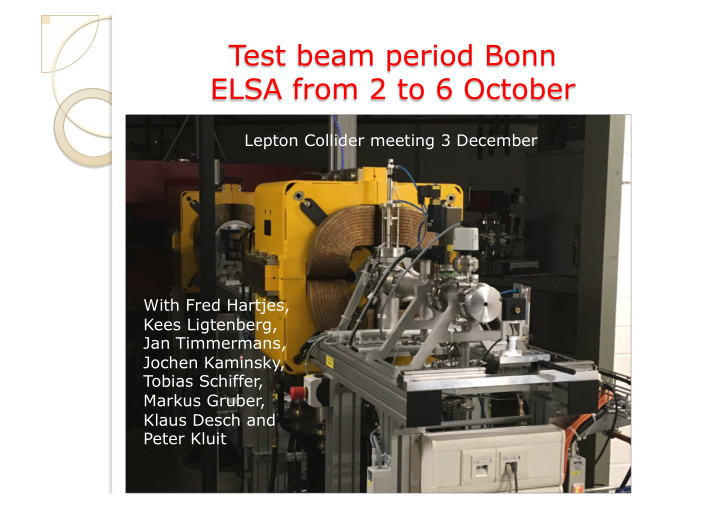



2013 Lepton Collider meeting 3 December With Fred Hartjes, Kees Ligtenberg, Jan Timmermans, Jochen Kaminsky, Tobias Schiffer, Markus Gruber, Klaus Desch and Peter Kluit
Last meeting 19 November Kees showed the issues with 2013 the Timepix synchronisation. Here we report the progress in diagnosting and understanding this aspect. The basic idea (from Martin) is that due to the high rate the Timepix data is shifted and gets another Spider time stamp. By looking at different data sets we can diagnost this using the nr of hits per 409 microsec. Entries quad chip 0 (RMS = 54.26) quad chip 1 (RMS = 55.52) Run668 300 quad chip 2 (RMS = 80.85) quad chip 3 (RMS = 53.45) single chip (RMS=180 for 20 < N < 1000) Latest Quad hits 250 200 The blue: 150 published 100 low rate test beam 50 0 100 200 300 400 500 600 700 800 900 1000 N hits
2013 Run 667 with the new (second) quad was taken at a higher threshold. It is a bit better but still saturation at 550 hits per chip per 409 microsec. 400 Entries quad chip 0 (RMS = 29.17) quad chip 1 (RMS = 49.94) 350 quad chip 2 (RMS = 20.46) quad chip 3 (RMS = 17.40) Run667 single chip (RMS=180 for 20 < N < 1000) hits 300 Latest Quad 250 200 The blue: published 150 low rate test 100 beam 50 0 100 200 300 400 500 600 700 800 900 1000 N hits
Run 632 with the first quad was taken at a higher 2013 threshold. It is a bit better than the other runs. It is however clear that run627 taken at a lower HV is in much better shape. So a lower hit rate. For the Conference results we decided to focus on run 627. Run632 first quad Run 627 at lower HV 400 400 Entries Entries quad chip 0 (RMS = 19.18) quad chip 1 (RMS = 17.60) quad chip 0 (RMS = 167.40) quad chip 1 (RMS = 162.11) 350 350 quad chip 2 (RMS = 162.27) quad chip 3 (RMS = 66.78) quad chip 2 (RMS = 156.64) quad chip 3 (RMS = 160.46) single chip (RMS=180 for 20 < N < 1000) single chip (RMS=180 for 20 < N < 1000) hits hits 300 300 250 250 200 200 150 150 100 100 50 50 0 0 100 200 300 400 500 600 700 800 900 1000 100 200 300 400 500 600 700 800 900 1000 N N hits hits
2013 Can we recuperate the data that is trigger shifted? How far should we look “forward” (up to 200)? To study this we use the Telescope track and plot the residuals (in xy or drift) vs nr of shifted triggers. A difficult run Run 667
Can we recuperate the data that is trigger shifted? 2013 Yes if we go up to 200 triggers (worst case) Chip 0 Chip 1 Different for every chip due to the rate For Chip 1 one does not have to Chip 3 Chip 2 go that far
After recuperation the nr of hits on track for all chips. 2013 This looks quite fine. Chip 0 Chip 1 A difficult run Run 667 Chip 2 Chip 3
2013 Now an easy case: run 627 same distributions Clearly just going up to 4 is good enough. Chip 0 Chip 1 Chip 3 Chip 2
We know how to deal with the time synchronization. 2013 In general just look forward by 200 trigger time stamps (of 409 micro sec) for data with high hit rates. There is an easier case - run 627 - where the hit rate was lower and one can just has to go up to 4 stamps. For the conference results of the quad we will first analyse run 627 with the first quad. Later we can include also the other runs with the second quad.
Recommend
More recommend